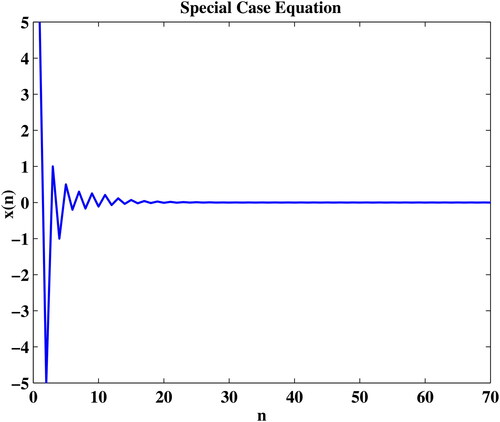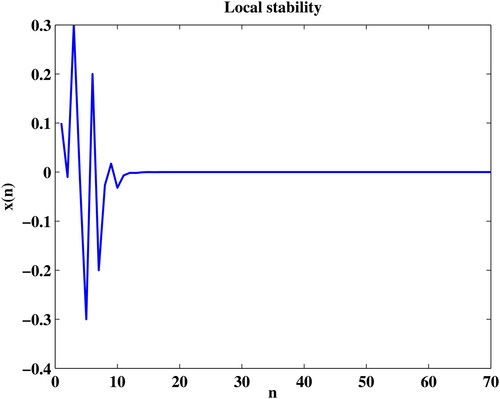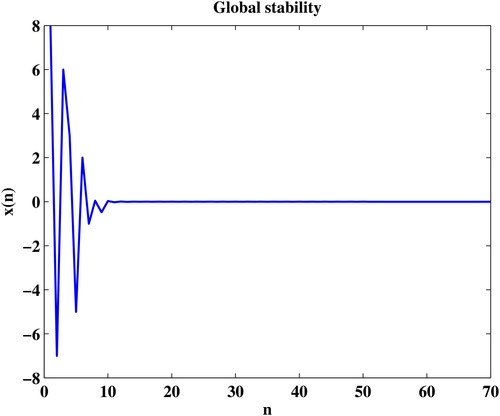 ?Mathematical formulae have been encoded as MathML and are displayed in this HTML version using MathJax in order to improve their display. Uncheck the box to turn MathJax off. This feature requires Javascript. Click on a formula to zoom.
?Mathematical formulae have been encoded as MathML and are displayed in this HTML version using MathJax in order to improve their display. Uncheck the box to turn MathJax off. This feature requires Javascript. Click on a formula to zoom.Abstract
Most qualitative behaviours of difference equations are rapidly investigated nowadays. This can be attributed to the fact that it is often sophisticated to construct the exact solutions of most difference equations. This article is written to analyse the local stability, global attractor and the boundedness of the solution of the seventh order difference equation given by
where the coefficients are supposed to be positive real numbers and the initial conditions
are arbitrary non-zero real numbers. Under some suitable conditions, the stability, boundedness and a special case equation from the considered equation are presented in 2 D figures.
Mathematics Subject Classification:
1. Introduction
The theory of difference equations has attained its popularity in recent decades due to its use in modelling most real life phenomena. It is worth mentioning that the difference equations are utilized in modelling some problems such as biological, physical, economical problems and several others. In order to understand the long behaviour of such models, one can study the qualitative and quantitative behaviours of these problem. This can be easily achieved by exploring the stability, periodicity and boundedness of the solutions.
Most researchers are mainly interested in studying difference equations of low order. As a result, simple analysis is required to investigate such equations. However, considering difference equations of high order leads to a very interesting, powerful and rigorous analysis. In this work, we present local and global stability for seventh order difference equations which can be generalized for other equations with higher orders. Indeed, such equations appear naturally as discrete analogues for differential equations which model a massive number of natural phenomena (Agarwal, Citation1992; Fisher, Citation1984; Kocic & Ladas, Citation1993). Thus, we are excited to study such proposed equations.
Recently, many authors have comprehensively analysed some relevant properties. Among some existing articles, we mention Moaaz, Chalishajar, and Bazighifan (Citation2019) analysed a general class of difference equations on the form
and presented suitable conditions for the local asymptotic stability and investigated the periodic solutions of these equations. In 1999, Amleh et al. (Amleh, Grove, Georgiou, & Ladas, Citation1999) explored the global attractivity, the periodic character and the boundedness nature of the positive solutions of the recursive equation
(1)
(1)
EquationEquation (1)(1)
(1) was also studied by Hamza (Citation2006) for negative
Almatrafi and Alzubaidi (Citation2019) concentrated on constructing the asymptotic stability, periodicity and boundedness of the rational difference equation
In Almatrafi (Citation2019), the author presented the forms of solutions of the system
Garić-Demirović, Nurkanović, and Nurkanović (Citation2017) analysed the periodicity and stability of the solution of the equation
Several articles are devoted to show the qualitative behaviours of some difference equations. Among these are refs. (Abdelrahman, 2019; Abdelrahman, Chatzarakis, Tongxing, & Osama, Citation2018; Almatrafi, Elsayed, & Alzahrani, Citation2019; Almatrafi & Elsayed, Citation2018; Almatrafi, Elsayed, & Alzahrani, Citation2018; Belhannache, Touafek, & Abo-Zeid, Citation2016; Elabbasy, El-Metawally, & Elsayed, Citation2008; El-Moneam & Zayed, Citation2014; Khaliq & Hassan, Citation2018; Khyat, & Kulenović, Citation2017; Kocic & Ladas, Citation1993; Kostrov & Kudlak, Citation2016; Liu, Li, Han, & Zhong, Citation2018; Moranjkić & Nurkanović, Citation2017; Saleh & Aloqeili, Citation2005; Simsek, Cinar, & Yalcinkaya, Citation2006).
It is the fundamental aim of this work to discuss some mathematical aspects, for example the stability and boundedness, for the following recursive equation:
(2)
(2)
where the coefficients
are positive real numbers. It is to be noted that the initial data is arbitrarily real numbers. Furthermore, this paper presents exact and numerical solutions to a special case from EquationEquation (2)
(2)
(2) .
2. Local stability of the equilibrium point
The local stability in the neighbourhood of the fixed point is extensively highlighted in this section. We provide special conditions under which the equilibrium point is locally asymptotically stable. The equilibrium point is given by
If then the unique equilibrium point is given by
We now introduce a new function to obtain the stability of EquationEquation (2)
(2)
(2) . Define a function
by
(3)
(3)
Hence,
(4)
(4)
(5)
(5)
(6)
(6)
The following step is embodied in evaluating EquationEquations (4)(4)
(4) , Equation(5)
(5)
(5) and EquationEquation (6)
(6)
(6) at
That is
Thus, the linearized equation of EquationEquation (2)(2)
(2) around
can be presented as follows:
Theorem 1.
Let and assume that
Then, the equilibrium point of EquationEquation (2)(2)
(2) is locally asymptotically stable.
Proof.
According to Theorem A in (Elabbasy et al., Citation2008), the local stability of the equilibrium point occurs if
(7)
(7)
Substituting into EquationEquation (7)
(7)
(7) leads to
(8)
(8)
If then EquationEquation (8)
(8)
(8) leads to
which can be reduced to
Theorem 2.
Suppose that and let
Then, the equilibrium point of EquationEquation (2)(2)
(2) is locally asymptotically stable.
Proof.
The proof is similar to the proof of Theorem (1). Hence, it omitted.
3. Analysis of global stability
This section is included to illustrate the global attractivity of the equilibrium point. The investigation of this part is established by employing Theorem B in (Elsayed, Citation2010).
Theorem 3.
Assume that Then, the equilibrium point of Equation (2) is a global attractor if
Proof.
Let and assume that
is a function defined by EquationEquation (3)
. Then, it can be apparently noted from EquationEquations (4)
(4)
(4) , Equation(5)
(5)
(5) and EquationEquation (6)
(6)
(6) that g is increasing in
and in θ and decreasing in
Theorem B in (Elsayed, Citation2010) requires a solution (say
) to the following system:
Or,
which can be expanded as follows:
(9)
(9)
(10)
(10)
Now, we subtract EquationEquation (10)(10)
(10) from EquationEquation (9)
(9)
(9) to obtain
which can be rearranged as
Therefore, if then
As a result, Theorem B (Elsayed, Citation2010) concludes that the equilibrium point is a global attractor.
Theorem 4.
Assume that Then, the equilibrium point of EquationEquation (2)
(2)
(2) is a global attractor if
Proof.
The proof is similar to the previous proof. Thus, it is omitted.
4. Exact solution to 

This section provides sophisticated forms of solutions to the following rational recursive relation:
(11)
(11)
where the initial data as shown previously.
Theorem 5.
Let be a solution to EquationEquation (11)
(11)
(11) and assume that
. Then, for
we have
Proof.
It is simply shown that the solutions are true for Suppose that nS> 0 and that our assumption holds for
That is,
We now turn to prove some formulae. It can be easily obtained from EquationEquation (11)(11)
(11) that
Since
it can be concluded that
Another formula can be proved as follows.
Since
we have
The rest of the relations can be similarly confirmed.
5. Confirmation of the results
Our main goal in this part is to verify the appropriate and vital results obtained in this article.
Example 1.
depicts the local asymptotic behaviour of the solutions around the equilibrium. The values of the constants are successfully selected by
Example 2.
This example is allocated to show the global nature of the solutions under the values See .
Example 4.
We plot in the behaviour of EquationEquation (11)(11)
(11) under some random initial conditions which are
6. Conclusion
In brief, we have shown the stability of EquationEquation (2)(2)
(2) under some powerful and effective hypotheses. In particular, the local stability of the fixed point occurs if
and the global behaviour of the equilibrium point takes place if
as can be observed in and , respectively. Other conditions for the local and global stability are discovered and illustrated. In Section 4, the exact solution of EquationEquation (11)
(11)
(11) has been perfectly determined using Fibonacci sequence.
Figure 3. The behaviour of EquationEquation (11)(11)
(11) at

Disclosure statement
No potential conflict of interest was reported by the author(s).
References
- Abdelrahman, M. A. E. (2019). On the difference equation zm+1=f(zm,zm−1,…,zm−k). Journal of Taibah University for Science, 13(1), 1014–1021. doi:10.1080/16583655.2019.1678866
- Abdelrahman, M. A. E., Chatzarakis, G. E., Tongxing, L., & Osama, M. (2018). On the difference equation xn+1=axn−l+bxn−k+f(xn−l,xn−k), Advances in Difference Equations, 431, 1–14. doi:10.1186/s13662-018-1880-8.
- Agarwal, R. P. (1992). Difference equations and inequalities: Theory, Methods and Applications. New York: Marcel Dekker.
- Almatrafi, M. B. (2019). Solutions structures for some systems of fractional difference equations. Open Journal of Mathematical Analysis, 3(1), 52–61. doi:10.30538/psrp-oma2019.0032
- Almatrafi, M. B., & Alzubaidi, M. M.. (2019). Analysis of the qualitative behaviour of an eighth-order fractional difference equation. Open Journal of Discrete Applied Mathematics, 2(1), 41–47. doi:10.30538/psrp-odam2019.0010
- Almatrafi, M. B., & Elsayed, E. M. (2018). Solutions and formulae for some systems of difference equations. MathLAB Journal, 1(3), 356–369.
- Almatrafi, M. B., Elsayed, E. M., & Alzahrani, F. (2018). Qualitative behavior of two rational difference equations. Fundamental Journal of Mathematics and Applications, 1(2), 194–204. doi:10.33401/fujma.454999
- Almatrafi, M. B., Elsayed, E. M., & Alzahrani, F. (2019). Qualitative behavior of a quadratic second-order rational difference equation. International Journal of Advances in Mathematics, 2019(1), 1–14.
- Amleh, A. M., Grove, E. A., Georgiou, D. A., & Ladas, G. (1999). On the recursive sequencexn+1=α+xn−1/xn,. Journal of Mathematical Analysis and Applications, 233(2), 790–798. doi:10.1006/jmaa.1999.6346
- Belhannache, F., Touafek, N., & Abo-Zeid, R. (2016). On a higher-order rational difference equation. Journal of Applied Mathematics & Informatics, 34(5-6), 369–382. doi:10.14317/jami.2016.369
- Elabbasy, E.M., El-Metawally, H., & Elsayed, E.M. (2008). On the difference equation xn+1=axn−(bxn)/(cxn−dxn−1),. Advances in Difference Equations, 4(17), 1–10. doi:10.1155/ADE/2006/82579
- El-Moneam, M. A., & Zayed, E. M. E. (2014). Dynamics of the rational difference equation. Information Sciences Letters, 3(2), 45–53. doi:10.12785/isl/030202
- Elsayed, E. M. (2010). Dynamics of recursive sequence of order two. Kyungpook Mathematical Journal, 50(4), 483–497. doi:10.5666/KMJ.2010.50.4.483
- Fisher, M. E. (1984). Stability of a class of delay-difference equations. Nonlinear Analysis, Theory, Methods and Applications, 8(6), 645–654. doi:10.1016/0362-546X(84)90009-9
- Garić-Demirović, M., Nurkanović, M., & Nurkanović, Z. (2017). Stability, periodicity and Neimark-Sacker bifurcation of certain homogeneous fractional difference equations. International Journal of Difference Equations, 12(1), 27–53.
- Hamza, A. E. (2006). On the recursive sequence xn+1=α+xn−1/xn,. Journal of Mathematical Analysis and Applications., 322, 668–674.
- Khaliq, A., & Hassan, S.S. (2018). Dynamics of a rational difference equation xn+1=axn+(α+βxn−k)/(A+Bxn−k),. International Journal of Advances in Mathematics, 159–179. 2018 (1)
- Khyat, T., & Kulenović, M. R. S. (2017). The invariant curve caused by Neimark-Sacker bifurcation of a perturbed Beverton-Holt difference equation. International Journal of Difference Equations, 12(2), 267–280.
- Kocic, V. L., & Ladas, G. (1993). Global behavior of nonlinear difference equations of higher order with applications. Dordrecht: Kluwer Academic.
- Kostrov, Y., & Kudlak, Z. (2016). On a second-order rational difference equation with a quadratic term. International Journal of Difference Equations, 11(2), 179–202.
- Liu, K., Li, P., Han, F., & Zhong, W. (2018). Global dynamics of nonlinear difference equation xn+1=A+xn/xn−1xn−2. Journal of Computational Analysis and Applications, 24(6), 1125–1132.
- Moaaz, O., Chalishajar, D., & Bazighifan, O. (2019). Some qualitative behavior of solutions of general class of difference equations. Mathematics, 7(7), 585. doi:10.3390/math7070585
- Moranjkić, S., & Nurkanović, Z. (2017). Local and global dynamics of certain second-order rational difference equations containing quadratic terms. Advances in Dynamical Systems and Applications, 12(2), 123–157.
- Saleh, M., & Aloqeili, M. (2005). On the rational difference equation yn+1=A+yn−kyn. Applied Mathematics and Computation 171(1), 862–869.
- Simsek, D., Cinar, C., & Yalcinkaya, I. (2006). On the recursive sequence xn+1=xn−31+xn−1. International Journal of Contemporary Mathematical Sciences, 1, 475–480. doi:10.12988/ijcms.2006.06052


